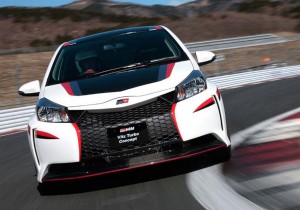Toyota is hoping to take a giant leap into the future with the help of the Great Gazoo. That’s Gazoo Racing Masters of Nurburgring, or GRMN, which partnered with the giant automaker to pull together a turbocharged version of the Toyota Vitz for the recent Tokyo Auto Salon.
The 178-horsepower subcompact – known in much of the rest of the world as the Yaris – is more than a one-off show car, however. Industry sources say it’s a sign of things to come from Toyota, which has been focusing the major portion of its engineering resources on gas-electric hybrids while most of its key competitors are racing to market with downsized, direct injection turbo engines.
Turbos may not yield quite the urban fuel economy of a hybrid but they deliver more customer-pleasing performance than the typically anemic hybrid, along with improved highway mileage. They’re also, typically, a lot cheaper than hybrid systems that depend on more complex driveline components, including expensive battery packs.
Toyota has also lagged behind on several other key powertrain developments, including direct injection – a more efficient ways of pumping the fuel/air mixture into an engine’s cylinders that can boost both performance and mileage – and next-generation transmissions. Though it offers a state-of-the-art 8-speed automatic on its flagship Lexus LS sedan, the compact crossover the RAV-4 still relies on a dated 4-speed.
But the Yaris GRMN Turbo shown at the Tokyo Auto Salon is apparently a sign that Toyota is getting ready to quite literally shift gears. According to various sources, the maker has an aggressive development program underway to catch up on the development of direct injection – or DI – and turbocharged engines, with a number of small and midsized products likely to get the more advanced powertrains in the next few years.
“They’re not going to be able to keep up otherwise,” says Dave Sullivan, an analyst with the consulting firm AutoPacific, Inc.
According to one report in a small Japanese business daily, the first DI turbo engines could begin to appear in domestic Toyota products, such as the Crown model, as early as 2013. The maker also plans to roll out those powertrains in models it sells in China and Europe.
While the report did not specifically cite plans for the U.S., “We expect it to be a potential market for such technology to further increase the competitiveness of (Toyota) products,” says Kurt Sanger, an automotive analyst with Deutsche Bank.
He and other sources contacted by TheDetroitBureau.com anticipate that the next-generation Corolla is the model most likely to get Toyota’s first direct injection turbo engine – though Sanger believes a turbocharged inline-four could be added to the powertrain options for the current-generation Camry sedan “without waiting for a full model change.”
Turbocharged engines are rapidly becoming a common option for makers ranging from Hyundai to Ford – the last selling its offerings under the EcoBoost label. They typically command a premium of $1,000 or more, but the added cost is usually a lot less than for a hybrid option. The midsize Hyundai Sonata Hybrid starts at $26,610, with the MSRP for the Sonata 2.0T set at $24,645.
Until now, says Sullivan, Toyota “has made it clear hybrids are their strategy.” As recently as this month, Jim Lentz, the CEO of Toyota Motor Sales USA, reiterated the maker’s position that it plans to offer a hybrid option in “just about everything we offer.”
That may eventually pay off as federal mileage standards rapidly rise, but U.S. motorists, in particular, have shown a surprising indifference to the technology. The Toyota Prius is the segment’s best-seller, accounting for nearly half of all hybrid sales in 2011, but add up all the gas-electric vehicles on the market and hybrids generated a collective 274,927 sales last year. Ford is nearing that number with its EcoBoost alone.
Part of the challenge for Toyota has been that the maker had to divert a major chunk of its engineering resources to resolve quality and safety issues that forced it to recall more than 17 million vehicles over the last several years. It is reportedly working with outside firms, like GRMN, to help it fire up its turbo development efforts.
Toyota isn’t the only Japanese maker to be slow on the draw with turbos and direct injection. Honda officials were long reluctant to embrace the technologies, also in part because of their focus on hybrid technology. But Honda unveiled a line-up of new DI and turbocharged engines during the recent Tokyo Motor Show, collectively known as EarthDreams technology. They will begin appearing in the Honda line-up with the launch of upcoming products like the 2013 Accord.

